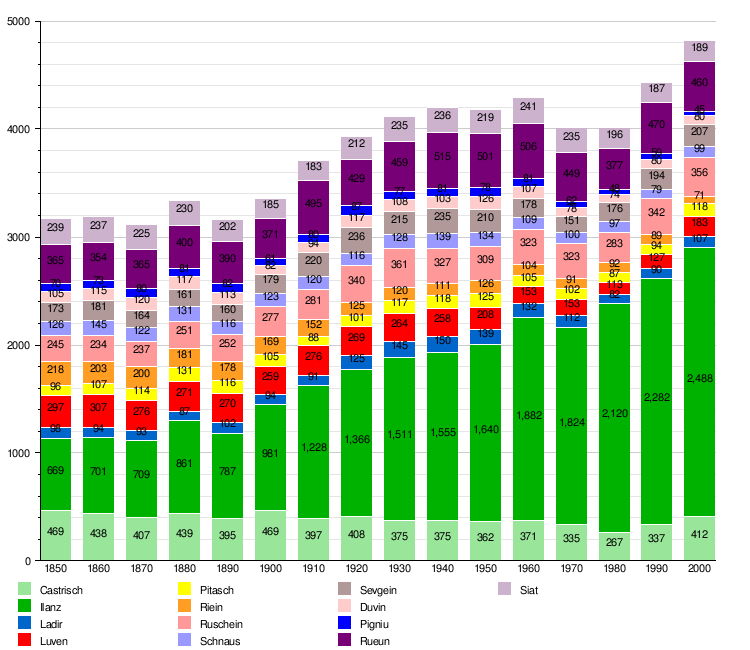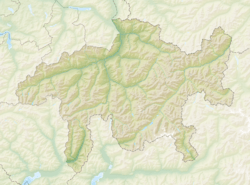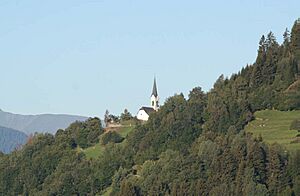Ilanz/Glion facts for kids
Quick facts for kids
Ilanz/Glion
|
||
|---|---|---|
 |
||
|
||
| Country | Switzerland | |
| Canton | Graubünden | |
| District | Surselva | |
| Area | ||
| • Total | 133.48 km2 (51.54 sq mi) | |
| Population
(Dec 2020 )
|
||
| • Total | 4,797 | |
| • Density | 35.938/km2 (93.079/sq mi) | |
| Postal code |
7130
|
|
| Localities | Ilanz/Glion, Strada, Castrisch, Ladir, Luven, Pitasch, Riein, Ruschein, Schnaus, Sevgein, Duvin, Pigniu, Rueun, and Siat | |
| Surrounded by | Schluein, Sagogn, Safiental, Vals, Lumnezia, Obersaxen Mundaun, Waltensburg/Vuorz, Andiast, Glarus Süd (GL) | |
Ilanz/Glion (German: Ilanz [ˈiːlants]; Romansh: Glion [ʎɔn]) is a municipality in the Surselva Region in the Swiss canton of Graubünden. On 1 January 2014 the former municipalities of Castrisch, Ilanz, Ladir, Luven, Pitasch, Riein, Ruschein, Schnaus, Sevgein, Duvin, Pigniu, Rueun, and Siat merged into the new municipality of Ilanz/Glion.
Contents
History
| Settlement | First mention | Ref. | |
|---|---|---|---|
| Date | Name | ||
| Castrisch | 765 | Castrices | |
| Ladir | c. 850 | Leitura | |
| Luven | 765 | Lobene | |
| Pitasch | c. 801–850 from a 16th-century copy of the lost original |
Pictaui | |
| 960 | in Pictaso | ||
| Riein | 765 | Renino | |
| 960 | Raine | ||
| Ruschein | 765 | Rucene | |
| Schnaus | c. 840 | Scanaues | |
| Sevgein | c. 840 | Soviene | |
| Duvin | c. 840 | Auna | |
| 1290 | Aiuns | ||
| Rueun Ruis until 1943 |
765 | Ruane | |
| Siat Seth until 1943 |
c. 840 | Septe | |
Ilanz
Ilanz is first mentioned in 765 as Iliande. Ilanz became the capital of the newly formed Grey League in 1395. The Grey League was the second of Three Leagues which eventually formed canton Graubünden. Johannes von Ilanz, the Abbott of Disentis, was among the three nobles instrumental in creating this "eternal alliance."
Ilanz has a special place in the history of the Protestant Reformation. In the 1520s, the Diet of Ilanz declared that citizens of the Three Leagues should be free to choose between Catholicism and the Protestant forms of Christianity rising to the fore. These and other events resulted in a counter-reformation within the Swiss Confederation that reversed many of the gains of the Reformation in Switzerland.
Pigniu
Pigniu was probably settled from Andiast. The name Pingyow first appears in 1403. The German name Panix is first mentioned in 1522. Until 1984 Pigniu was known as Pigniu/Panix.
The Church of St. Valentin was dedicated in 1465 and was a popular goal of pilgrimages. Until 1667, Pigniu had its parish.
On 7 October 1799, the Russian Army under command of Field Marshal Suvorov crossed the Pigniu pass.
Geography
The former municipalities that now makeup Ilanz/Glion have a total combined area of 133.48 km2 (51.54 sq mi).
Demographics
The total population of Ilanz/Glion (as of December 2020[update]) is 4,797.
The historical population is given in the following chart:

Weather
Ilanz has an average of 112.6 days of rain per year and on average receives 952 mm (37.5 in) of precipitation. The wettest month is August during which time Ilanz receives an average of 102 mm (4.0 in) of precipitation. During this month there is precipitation for an average of 11.4 days. The month with the most days of precipitation is June, with an average of 11.5, but with only 93 mm (3.7 in) of precipitation. The driest month of the year is October with an average of 63 mm (2.5 in) of precipitation over 11.4 days.
Pigniu has an average of 166.3 days of rain or snow per year and on average receives 1,347 mm (53.0 in) of precipitation. The wettest month is August during which time Pigniu receives an average of 141 mm (5.6 in) of rain or snow. During this month there is precipitation for an average of 16 days. The month with the most days of precipitation is May, with an average of 16.6, but with only 124 mm (4.9 in) of rain or snow. The driest month of the year is October with an average of 90 mm (3.5 in) of precipitation over 16 days.
Sights
The village Church of St. Zeno in Ladir was first mentioned in 998. The choir wall paintings are worth seeing. Additionally, the municipality has an excellent view of the surrounding mountains and valleys. The ruins of Grüneck Castle (Ruine Grüneck), destroyed before 1544, are visible today in Ilanz village.
Heritage sites of national significance
The Church of S. Margreta and the Church of S. Martin in Ilanz along with the Swiss Reformed Church building in Pitasch are listed as Swiss heritage sites of national significance.
The Reformed Church in Pitasch was built in the mid-12th century into its current form. The church floorplan is a single nave church with a single half-round apse. The interior murals date to about 1420, and on the exterior south wall is a mural of St. Martin and St. Christopher from the studio of the unknown Waltensburg Master which was painted about 1340.
Transportation
The municipality has three railway stations: Castrisch, Ilanz, and Rueun. All three are located on the Reichenau-Tamins–Disentis/Mustér line with regular service to Disentis/Mustér and Scuol-Tarasp.










